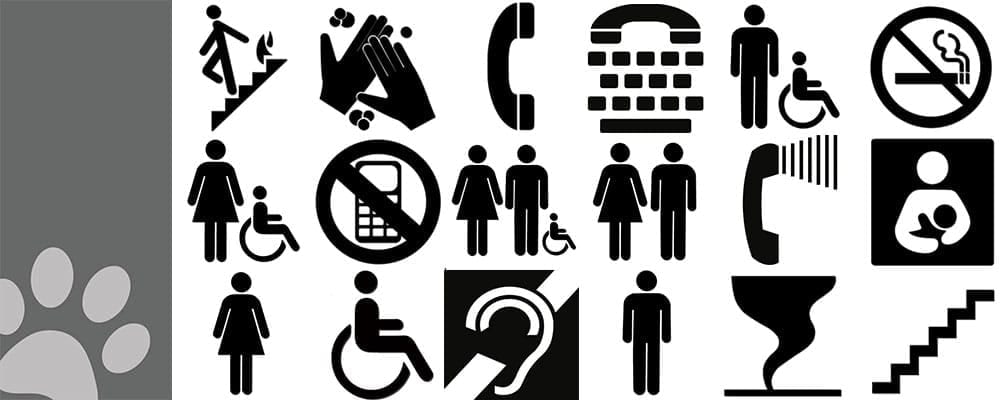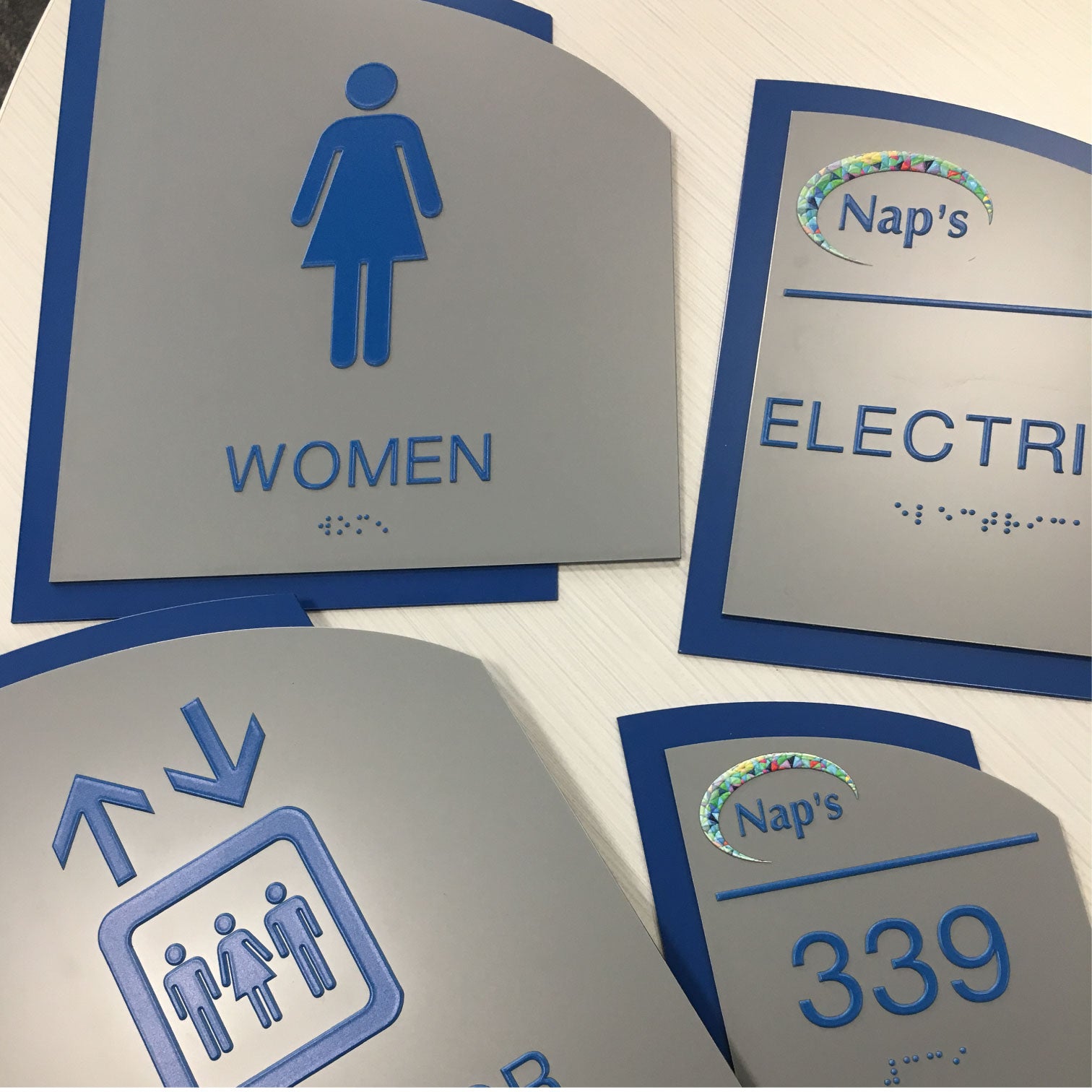Check out the Relevance of ADA Signs in Public Spaces
Check out the Relevance of ADA Signs in Public Spaces
Blog Article
Exploring the Key Functions of ADA Indications for Improved Ease Of Access
In the world of accessibility, ADA signs work as silent yet effective allies, making sure that rooms are inclusive and accessible for people with handicaps. By integrating Braille and responsive aspects, these signs damage barriers for the visually impaired, while high-contrast color design and clear font styles satisfy diverse aesthetic requirements. Their tactical positioning is not arbitrary yet instead a computed effort to promote smooth navigating. Past these features lies a deeper story regarding the evolution of inclusivity and the continuous dedication to creating fair spaces. What much more could these indicators indicate in our pursuit of global availability?
Value of ADA Conformity
Guaranteeing compliance with the Americans with Disabilities Act (ADA) is essential for cultivating inclusivity and equal gain access to in public spaces and work environments. The ADA, passed in 1990, mandates that all public facilities, employers, and transport services suit individuals with specials needs, guaranteeing they delight in the exact same civil liberties and opportunities as others. Conformity with ADA standards not just meets lawful responsibilities yet additionally enhances an organization's track record by demonstrating its commitment to diversity and inclusivity.
One of the vital facets of ADA conformity is the execution of accessible signs. ADA indications are designed to ensure that individuals with impairments can quickly navigate through spaces and structures. These signs need to stick to particular standards regarding dimension, font, color contrast, and placement to guarantee presence and readability for all. Appropriately executed ADA signs helps get rid of barriers that individuals with specials needs often come across, thereby advertising their self-reliance and confidence (ADA Signs).
Furthermore, adhering to ADA guidelines can minimize the danger of possible penalties and lawful consequences. Organizations that fall short to adhere to ADA standards might encounter suits or charges, which can be both destructive and monetarily challenging to their public image. Hence, ADA conformity is essential to cultivating an equitable setting for every person.
Braille and Tactile Components
The unification of Braille and tactile elements into ADA signs symbolizes the concepts of ease of access and inclusivity. These attributes are critical for people that are visually damaged or blind, enabling them to browse public rooms with better freedom and confidence. Braille, a responsive writing system, is necessary in supplying created information in a format that can be conveniently regarded with touch. It is commonly put beneath the corresponding text on signs to make certain that individuals can access the info without visual help.
Responsive components extend beyond Braille and consist of raised personalities and icons. These elements are developed to be noticeable by touch, allowing individuals to determine room numbers, toilets, exits, and other essential locations. The ADA sets details standards pertaining to the size, spacing, and positioning of these responsive aspects to enhance readability and guarantee consistency throughout various atmospheres.

High-Contrast Color Systems
High-contrast color schemes play a pivotal function in boosting the exposure and readability of ADA signage for individuals with visual problems. These systems are crucial as they make the most of the difference in light reflectance in between message and background, making sure that signs are conveniently noticeable, even from a distance. The Americans with Disabilities Act (ADA) mandates using details color contrasts to fit those with limited vision, making it a vital facet of compliance.
The efficiency of high-contrast shades depends on their ability to stand out in various illumination conditions, including poorly lit settings and areas with glow. Generally, dark message on a light history or light text on a dark history is employed to achieve optimum contrast. Black message on a white or yellow background provides a raw visual difference that assists in quick acknowledgment and understanding.

Legible Fonts and Text Size
When taking into consideration the layout of ADA signage, the option of legible typefaces and suitable text size can not be overemphasized. The Americans with Disabilities Act (ADA) mandates that typefaces should be not italic and sans-serif, oblique, manuscript, very decorative, or of uncommon kind.
The dimension of the message also plays a crucial duty in ease of access. According to ADA guidelines, the minimal text elevation need to be 5/8 inch, and it should raise proportionally with checking out distance. This is especially crucial in public rooms where signage requirements to be checked out quickly and precisely. Uniformity in text dimension adds to a natural aesthetic experience, aiding people in browsing environments successfully.
Additionally, spacing between letters and lines is integral to readability. Appropriate spacing stops personalities from appearing crowded, enhancing readability. By sticking to these requirements, developers can considerably boost ease of access, making sure that signage serves its intended purpose for all individuals, no matter their visual capacities.
Efficient Placement Methods
Strategic positioning of ADA signage is necessary for making best use of availability and making sure conformity with lawful standards. Correctly located indications direct individuals with impairments effectively, assisting in navigating in public rooms. Key considerations consist of exposure, closeness, and height. ADA standards specify that indications ought to be installed at a height between 48 to 60 inches from the ground to guarantee they are within the line of view for both standing and seated people. This typical elevation array is essential for inclusivity, allowing wheelchair customers and people of varying heights to access info easily.
Additionally, indications must be placed Get More Info beside the lock side of doors to allow easy recognition prior to entry. This placement assists people situate areas and spaces without obstruction. In cases where there is no door, indicators need to be positioned on the nearest adjacent wall surface. Consistency in indicator placement throughout a center enhances predictability, decreasing confusion and improving general user experience.

Verdict
ADA indicators play a crucial role in promoting access by integrating features that resolve the requirements of individuals with handicaps. These aspects collectively promote an inclusive atmosphere, underscoring the value of ADA compliance in making sure equivalent gain access to for all.
In the realm of access, ADA signs go to my blog serve as quiet yet powerful allies, making sure that rooms are comprehensive and navigable for people with specials needs. The ADA, enacted in 1990, mandates that all public facilities, employers, and transport services suit people with handicaps, guaranteeing they take pleasure in the very same legal rights and chances as others. ADA Signs. ADA indications are designed to guarantee that people with disabilities can easily browse through structures and rooms. ADA standards specify that indicators ought to be mounted at a height between 48 to 60 inches from the ground to guarantee they are within the line of sight for both standing and seated people.ADA signs play an important function in promoting ease of access by integrating features that address the requirements of individuals with specials needs
Report this page